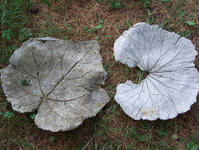A hard Summer...
It is disappointing when I don't have the time or energy to take care of things properly in the garden, but it seems to go in fits and starts. Once this heat breaks I hope to get out and do some basic maintenance that needs to be done.
The only bright spot in the loss of these plants is that they now provide me a few open spaces to transplant some roses from the back garden that are suffering from lack of sunlight.
Maybe if I make my plans now I will be able to squeeze a bit of gardening into my schedule. I know it does me well to get out into the garden, but life somehow intervenes at the worst possible moment.
On a related note, these week's tip from Garden Gate magazine gives pointers on moving plants even when the weather isn't the best for transplanting.
Moving a plant in the heat
With careful planning and planting, you can move a plant in the heat without injuring it. These 6 steps will help your plant travel easier.






